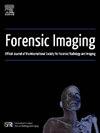多期死后计算机断层血管造影(MPMCTA)在支气管肺动脉瘘咯血中的应用
IF 1
Q4 RADIOLOGY, NUCLEAR MEDICINE & MEDICAL IMAGING
引用次数: 0
摘要
支气管肺动脉瘘(BPAF)是一种罕见的危及生命的疾病,是支气管与血管树之间的异常连接,临床表现为大咯血,死亡率高。在这里,我们报告了一例由于BPAF导致的致命大咯血,在多阶段尸检计算机断层血管造影(MPMCTA)协议下,通过尸检成像检测到瘘管。1例71岁男性患者出现持续咳嗽并伴有呼吸道大量出血,随后失去意识死亡。受试者烟瘾很大,死前曾抱怨持续干咳。行MPMCTA检查,然后进行尸检和组织学检查。尸检影像显示,在左肺门有一个病变,与先前未检测到的原发性肺肿瘤一致,MPMCTA记录了BPAF。通过死后成像,还观察到肝脏病变,提示转移。这些发现后来被尸检证实,组织学检查允许诊断原发性肺肿瘤和肝转移。本病例强调了死后血管造影技术在假设血管损伤为死亡原因的情况下的有用性,特别是在生命中没有放射图像的情况下。事实上,这些技术允许在解剖解剖之前检测导致死亡的急性血管损伤,任何额外的血管异常,以及影响血管损伤发生区域的解剖变异。本文章由计算机程序翻译,如有差异,请以英文原文为准。

Application of multiphase post-mortem computed tomography angiography (MPMCTA) in a case of hemoptysis due to bronchopulmonary arterial fistula
Bronchopulmonary arterial fistula (BPAF), an abnormal connection between the bronchus and the vascular tree, is a rare life-threatening condition whose clinical presentation is massive hemoptysis with high mortality rate. Here we present a case of fatal massive hemoptysis due to a BPAF in which the fistula was detected by postmortem imaging following the multiphase postmortem computed tomographic angiography (MPMCTA) protocol.
A 71-year-old man presented with an episode of persistent cough associated with profuse bleeding from the respiratory orifices, then lost consciousness and died. The subject was a heavy smoker and had complained of a persistent dry cough in the days before death. MPMCTA was performed, then autopsy and histological examination were carried out.
Postmortem imaging revealed the presence, at the left pulmonary hilum, of a lesion compatible with a, previously not detected, primary lung tumor, in the context of which MPMCTA documented a BPAF. Through postmortem imaging, a hepatic lesion, suggestive of a metastasis, was also observed. These findings were later confirmed by autopsy, and histologic examination allowed the diagnosis of primary lung tumor and liver metastasis.
The case presented here underscores the usefulness of postmortem angiography techniques in cases where vascular injury is hypothesized as the cause of death, especially if there are no radiological images performed during life. Indeed, these techniques allow to detect prior to anatomical dissection the acute vascular damage causative of death, any additional vascular abnormalities, as well as anatomical variants affecting the region where the vascular damage occurred.
求助全文
通过发布文献求助,成功后即可免费获取论文全文。
去求助
来源期刊

Forensic Imaging
RADIOLOGY, NUCLEAR MEDICINE & MEDICAL IMAGING-
CiteScore
2.20
自引率
27.30%
发文量
39
 求助内容:
求助内容: 应助结果提醒方式:
应助结果提醒方式:


